

The Heat — which just opened with a fantastic $39.1 million weekend — is the first major-release movie from a Hollywood studio this summer with more women in leading roles than men. Iron Man 3, Star Trek Into Darkness, Fast & Furious 6, The Hangover Part III, Now You See Me, After Earth, The Internship, The Purge, Man of Steel, This is the End, Monsters University, World War Z, and White House Down all are dominated with major male characters — and some have no significant female characters whatsoever.
This isn't exactly a new trend — movies in general and summer movies in particular have been dominated by men for years. But The Heat is just one of only two female-driven movies this summer with major releases (i.e. in 1,000 theaters or more) — the other is the coming-of-age sex comedy The To-Do List, out next month. It's a puzzling trend, especially considering that since 2008, movies like Sex and the City, Mamma Mia!, The Proposal, Julie & Julia, Salt, Bridesmaids, The Help, Brave, and now The Heat have all proven that audiences will in fact buy tickets for female-fronted films.
So what's the deal? The Heat director Paul Feig, for one, says he's "perplexed."
"I know that there are certain business models that float around that seem to say that men won't show up to see a woman in a movie but women will show up to see men in a movie," he says. "I also know that there's some business models that show that movies starring women don't export well, especially to places like Asia — and studios make so much money off of international now that maybe that's part of it. But for me, it just doesn't make any sense, because women are half the population of the world and they need entertainment. From a business level, it seems crazy to just completely under-serve that enormous of a market."
But are women actually being underserved? A BuzzFeed analysis of summer movie box office since 2008 makes clear that, on average, movies with male-dominated casts are grossing far more than movies where women make up the bulk of the main cast. And audiences are not flocking to female-driven films in the same volume on opening weekend as they do with male-driven films.
Virtually any way you measure it, women are coming up short at the summer box office, which leads to a thorny question: Are there fewer female-driven films because Hollywood is ignoring women, or because, on average, audiences are ignoring the female-driven films that are released?

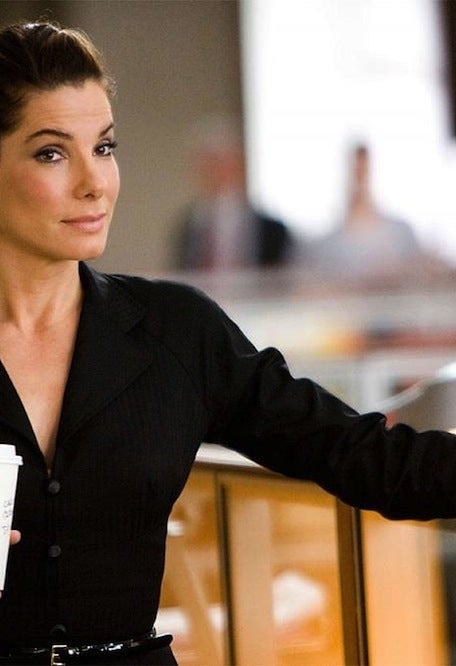

Before we dive into the nitty gritty of the numbers, a note on criteria. I focused only on movies released between the first weekend in May and the last full weekend in August, in 1,000 theaters or more, where the leading and/or major roles were dominated either by men or women. This is not an exact science. For example, not only did 2009's The Proposal feature Sandra Bullock, Betty While, Malin Akerman, and Mary Steenburgen in significant roles — whereas Ryan Reynolds and Craig T. Nelson were the only significant men — but, crucially, Bullock's character is the one who goes through the biggest transformation in the film, and Bullock's face and persona drove the marketing (yes, along with Reynolds' abs). So I included it in my calculations as a female-driven film. Meanwhile, 2009's Star Trek did provide Zoe Saldana some terrific scenes, but that pales in comparison to all the screen-time devoted to Chris Pine, Zachary Quinto, Simon Pegg, Leonard Nimoy, and Eric Bana. It counted as a male-driven movie.
On the flip side, movies like Thor, Friends with Benefits, The Time Travelers Wife, Scott Pilgrim vs. the World, The Twilight Saga: Eclipse, Bad Teacher, and X-Men: First Class had, in my judgment, a relatively equal balance of major male and female characters — namely, characters who drive the story and/or change over the course of the film. So they did not factor into my calculations.
One final note: It is easy to argue that female-driven films are at a major disadvantage when stacked up against the astronomic box office grosses of male-driven mega-blockbusters like The Avengers, Transformers: Dark of the Moon, The Dark Knight and The Dark Knight Rises. I don't disagree. But bear in mind that many movies with mostly male casts have been major box office flops, most of them comedies: Speed Racer, The Love Guru, Land of the Lost, Year One, The Change-Up, 30 Minutes or Less, Fright Night, Abraham Lincoln: Vampire Hunter, and The Watch were all big flops, and their terrible box office also factored into my calculations.
Of course, when those movies sputtered to a quick death at the box office, no one began asking if it meant audiences weren't interested anymore in male-driven films. "Sadly," says Feig, "there's much more of a litmus test being put on women's movies."
To begin, there are simply a lot more male-centric films than there are female:

Movies with mostly male casts have on average better opening weekends and better total grosses:

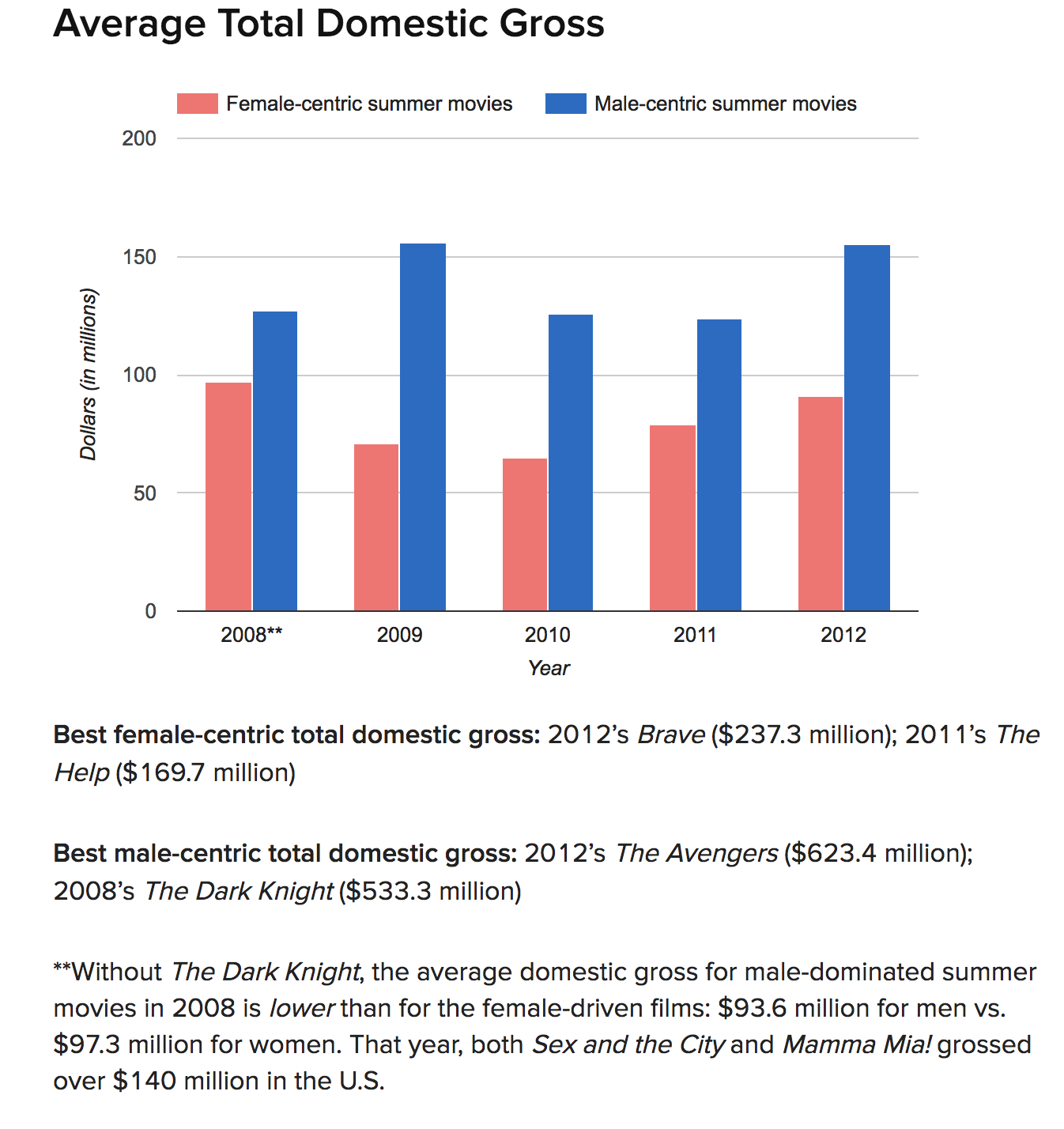
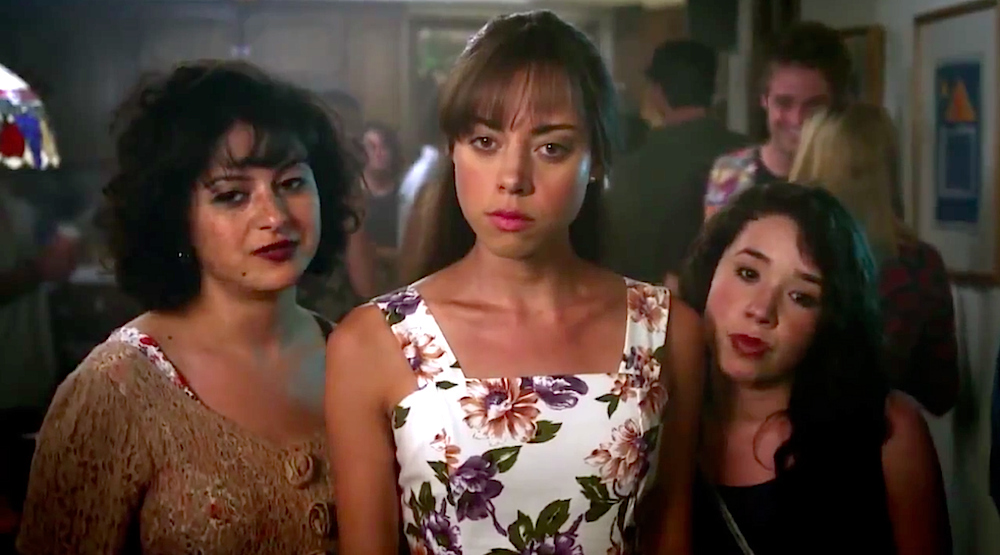
In the preceding three charts, the disparity between female- and male-centric films is pretty stark. The difference in foreign grosses has been especially enormous over the last few years, in part because female-driven movies with predominantly African American casts like 2012's Sparkle, 2011's Jumping the Broom, and 2010's Just Wright were barely released overseas — or not at all.
But it is worth dwelling for a second on 2008. That year, Sex and the City and Mamma Mia! were monster hits, especially overseas — the one and only arena, in fact, in which female-driven movies beat their male counterparts fair and square in this study, belying the conventional wisdom that movies with women don't do well overseas. Both films were based on properties that had already proven popular in other venues, much like most male-centric summer fare. And yet neither catered to a so-called "male" sensibility — no explosions, no car chases, with casts that were mostly over 40. As I've already noted, without The Dark Knight, 2008 would go to the women in the U.S. as well as abroad.
Did Hollywood notice? After 2008, studios did release at least one or two female-driven movies each summer in the vein of Sex and the City and Mamma Mia!: The Proposal in 2009, Sex and the City 2 and Eat Pray Love in 2010, Bridesmaids and The Help in 2011, and What to Expect When You're Expecting in 2012. Most were major hits. A couple, not so much.
At the same time, however, studios also released dozens of movies in the vein of The Dark Knight.
The biggest irony? "Men don't go to the movies as much [as women]," says Terry Press, a longtime Hollywood executive who is currently co-president of CBS Films, the mini-major studio releasing The To Do List on July 26. "Younger males are now the least reliable to turn out [for a movie]. Women go to the movies. When there's something women want to see, they turn out, both younger and older."
So why is Hollywood still making so many more movies geared towards men, and starring predominantly men, if young men aren't turning out to the movies as much as women? "Movies aimed at guys are so clearly aimed at guys," says Feig with a sigh. "It's just that women have over the years been conditioned that that's what they're going to get, so they go along with the guys to see the movie the guys want to see. It seems to be much easier for guys to get their girlfriend or wife to go with them to see a guy, verses the woman getting the guy to go see the quote-unquote chick flick."
This attitude within Hollywood has, in fact, led to a system in which studios consistently support their male-centric movies with bigger releases than their female-centric films.
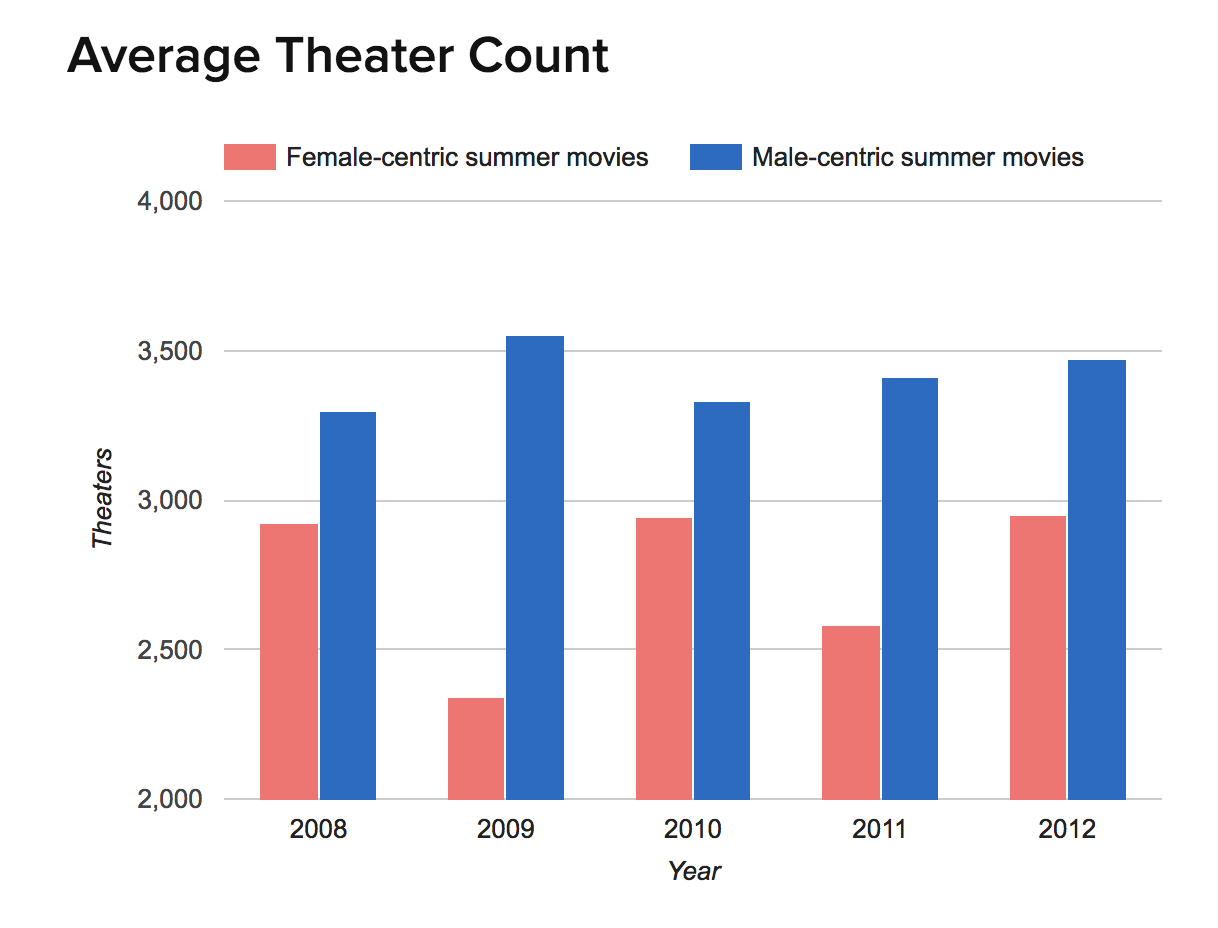
Almost every major male-centric summer movie since 2008 has opened in over 3,000 theaters. Of the 25 female-centric movies released since 2008, however, only seven have been afforded the same courtesy. As Linda Holmes points out in her terrific essay for NPR last month, it is difficult to see a movie with women if all the screens at your local multiplex are taken up by movies with men.
There is one box office measurement, however, where the female-centric films should be about even with the male-centric films: The opening weekend per-theater average. More than any other box office metric, this is the best indication of how many people are actually going to see any given movie, and the one that means the most to the major theater chains. If audiences were as hungry for female-driven movies as the success of movies like The Heat and The Proposal would indicate, on average, the theaters showing them would be at least as full — if not more so — as the theaters showing male-driven movies.
But that is not the case.
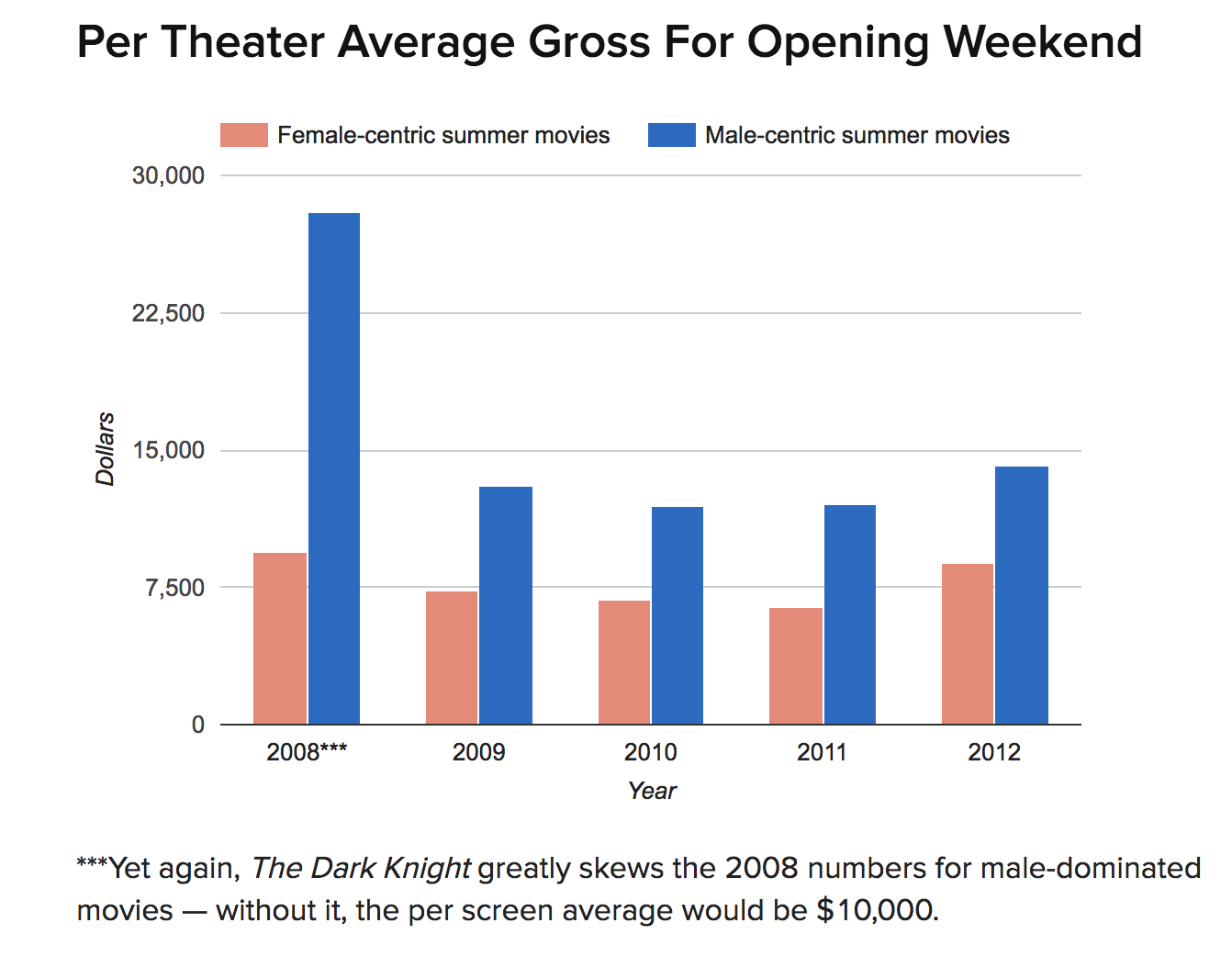
According to Press, one of the major issues driving these figures is that women don't rush out to see a movie on opening weekend. "Here's the thing: They go, but especially for older females, it has to be good," she says. Reviews and word-of-mouth, says Press, matter far more to women over 25 than any other demographic group — and they're willing to wait until they hear a movie is worth the ticket. "They will show up," she says. "They just show up over a longer period of time. I worked on Julie & Julia. It made almost $100 million, but it did it over, like, 10 weeks....Women are more discerning, period, the end. That's the truth. In everything."
In a system in which the opening weekend gross is held supreme above all else, that kind of selective moviegoing behavior has led studios to focus time, energy, and money on projects that are less beholden to concerns about relative quality — like, say, Transformers or Battleship.
"I think it's a bullshit excuse," counters Feig. "Anything that forces us to make better product is good. That's why social media's great. Gone are the days when you can put together a bunch of kick-ass trailers and put out a piece of shit and people buy into it. Now, the word goes out over social media on Friday — 'This is a piece of shit, don't go see it.' That will hurt you now."
Indeed, both Feig and Press say their respective marketing strategies for The Heat and The To Do List have hinged on a simple proposition: Show people the movie. "We did a ton of word-of-mouth screenings in the month leading up to the movie," says Feig. "But you have to have the goods."
"You hope with women that you're touching some kind of emotional chord that will resonate with them," says Press. "All you can really do is show the movie to girls and women, who then talk about the movie. The movie is the best selling point." (Press also notes that the fact that the film is directed by a woman, Maggie Carey, is a "unique" marketing feature that could also help it connect with female moviegoers.)
To aid word of mouth, CBS Films is releasing The To Do List in 600 theaters for the first two weeks, and then expanding wide in August.
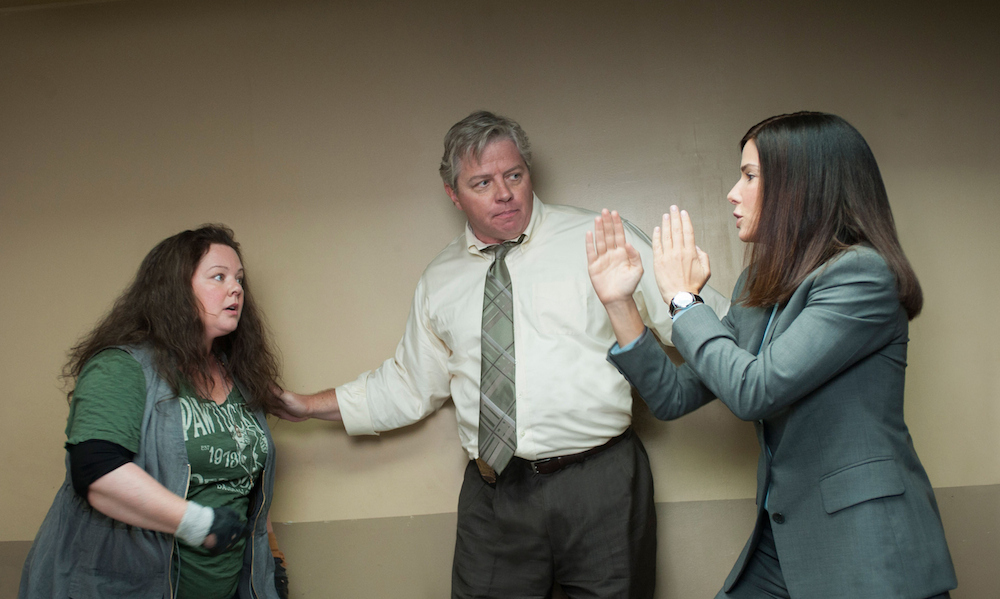
So Hollywood is left with a chicken-and-egg conundrum: Studios are reluctant to make female-centric movies because audiences are reluctant to race out to see female-centric movies because studios aren't making enough good female-centric movies to attract attention away from the male-centric movies that are dominating the marketplace.
How can this cycle be broken? For Feig, the solution may be as simple as casting Melissa McCarthy.
"I knew from Bridesmaids, which could not have looked more like a chick flick, that guys who got dragged along had a great time," he says. "And I think a big thing was Melissa was their key sherpa into that world. Like, 'Oh, man, she's really funny!' All the women in Bridesmaids are hilarious and not like, 'Oh, we're girls running around breaking nails!' But [Melissa] was the no-holds-barred intermediary. It felt like there was a good chance with The Heat to help break it down even more, for guys to go like, 'Oh yeah, she's funny! I'm going to go see her!'"
Press puts it a bit differently. "[McCarthy] doesn't fit any of the previous models for a movie star," she says. "She's not traditionally beautiful. She's not playing the Katherine Heigl-y romantic comedy lead. She's playing pretty much a guy. That is a new kind of movie star....If you made The Heat with Sandra Bullock and Julia Roberts, the movie wouldn't work."
Whether its with McCarthy, Bullock, Kristen Wiig, or some other actress, Feig says he would happily keep making movies starring funny women for the rest of his career — his next project is "a female spy action comedy" in the vein of James Bond. But it's also clear he is growing weary of being the sole torch-bearer for studio movies starring women — other (male) studio comedy directors like Todd Phillips (The Hangover), Adam McKay (Anchorman), and Jay Roach (The Campaign) clearly aren't racing to pack their movies with funny women.
"I'd like to get away from 'men' movies [and] 'women' movies, and just be like, a movie's a movie," says Feig. "If it happens to star all women, guys shouldn't be going 'Ugh, I can't go see that.' That to me is the long-term goal. But clearly it's an uphill slog. More people need to do it. If it's just going to be me doing it, it's going to be once every two years."
